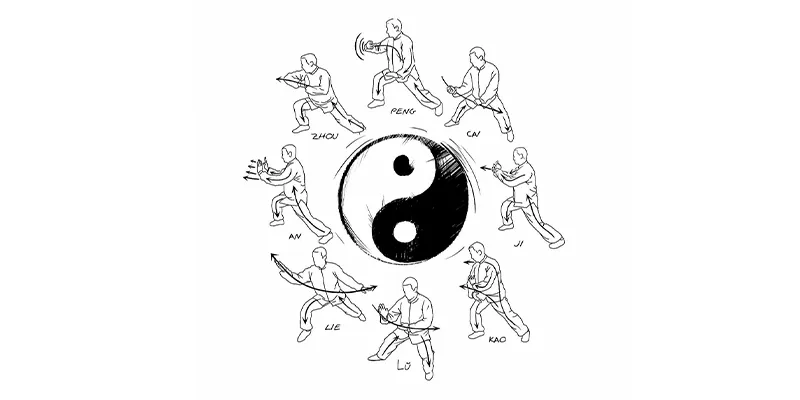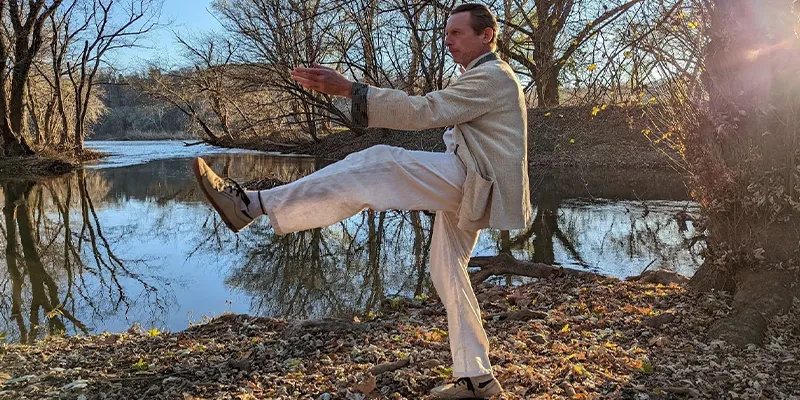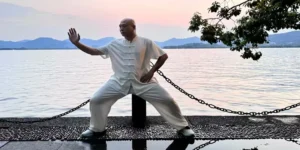
What Are 13 Postures Tai Chi?
13 Postures Tai Chi is the basic movements of Tai Chi. Each Tai Chi form is composed of one or more of the 13 postures.
The 13 Postures Tai Chi is composed of 13 words: Peng, Lu, Ji, An, Cai, Lie, Zhou, Kao, Jin, Tui, Gu, Pan, and Ding. They are the principles of Tai Chi practice, covering the training of Qi, Jin, and combat skills. The first eight words represent the eight trigrams, and the last five words represent the five elements, so 13-posture Tai Chi is also called Eight Gates and Five Steps.
13 postures, which are not static poses but dynamic principles represented by thirteen Chinese characters: eight correspond to directional energies (the “Eight Gates”), and five relate to footwork (the “Five Steps”). These 13 postures are also called the Thirteen Kinetic Principles or Thirteen Dynamics, forming the DNA of Tai Chi’s movement philosophy. In essence, the 13 postures tai chi transform Tai Chi from exercise into a holistic art of mind-body integration.
13 Postures Tai Chi History

Tai chi 13 postures trace their roots to 17th-century China, created by Chen Wangting, a Ming Dynasty general and founder of Chen-style Tai Chi. After the Ming collapse, Chen retired to his village, Chenjiagou, where he synthesized martial arts, Daoist philosophy, and Traditional Chinese Medicine. His innovation merged the Eight Trigrams/Bagua with the Five Elements/Wuxing (Wood, Fire, Earth, Metal, Water), creating the Eight Gates and Five Steps.
Unlike martial arts, tai chi 13 postures emphasized “soft overcoming hard” and circularity, drawing from Daoist concepts like wu wei. The Eight Gates mirrored the Bagua’s directional energies, while the Five Steps embodied elemental transitions. This fusion birthed Tai Chi as a moving meditation—balancing self-defense, health cultivation, and spiritual harmony. Over centuries, styles like Yang and Wu evolved, but all styles have the 13 Postures Tai Chi as their basis.
How To Do Tai Chi Chuan 13 Postures
The Eight Gates
Peng (Ward Off): An expansive, upward-scooping energy—like a balloon resisting pressure. Practice: In “Grasp Sparrow’s Tail,” raise arms with rounded elbows, deflecting force outward.
Lu (Roll Back): Yielding and redirecting, such as guiding an opponent’s lunge past you. Practice: Rotate palms inward while stepping back, spiraling energy downward.
Ji (Press): Consolidating force linearly, like a piston. Practice: Follow Lu by pressing palms forward, hips driving momentum.
An (Push): Sinking then upward-outward force—think waves crashing. Practice: Lower hands to hips, then push diagonally upward (as in “Push Mountain”).
Cai (Pluck): Sudden downward “plucking,” like snapping a twig. Practice: Use fingertips to jerk an opponent off-balance (e.g., in “Fair Lady Works Shuttles”).
Lie (Split): Torsional energy—twisting apart like wringing cloth. Practice: Arms rotate in opposite directions (left palm up, right down).
Zhou (Elbow Strike): Close-range power focused in the elbow. Practice: Strike horizontally after deflecting, keeping shoulders relaxed.
Kao (Shoulder Strike): Full-body impact using the shoulder/back. Practice: Sink weight, then drive shoulder forward (rooted in stances like “Embrace Tiger”).
The Five Steps
Jin (Advance): Stepping forward with intent—Wood’s growth. Practice: Shift weight smoothly, heel-toe placement.
Tui (Retreat): Flowing backward—water’s adaptability. Practice: Slide back, toes first, torso upright.
Gu (looking left): Metal (precision) and Fire (awareness). Practice: Rotate waist, eyes leading movement; e.g., “Wave Hands Like Clouds.”
Pan (Look Right): Metal (precision) and Fire (awareness). Practice: Rotate waist, eyes leading movement; e.g., “Wave Hands Like Clouds.”
Ding (Central Equilibrium): Earth’s stability. Practice: Root through feet, spine aligned, weight centered (e.g., “Golden Rooster Stands on One Leg”).
Benefits of Tai Chi 13 Postures

Physical Training: Training the body’s fundamental movement patterns and energies. Practicing Peng, Lü, Ji, An, and the other eight grades cultivates integrated whole-body coordination, structural alignment, and efficient force generation. Tai Chi 13 Postures practice significantly enhances dynamic balance, proprioception, joint stability, and functional strength. It develops the ability to move with relaxed power, improving agility, posture, and overall physical resilience by training the body to move as a unified, grounded structure.
Physiological and Stress Adjustments: Engaging in the mindful, flowing execution of the 13 postures tai chi induces a state of calm alertness that positively influences the autonomic nervous system. The combination of deep, diaphragmatic breathing coordinated with slow, continuous movements promotes parasympathetic dominance. This leads to measurable physiological benefits such as reduced heart rate and blood pressure, lowered levels of stress hormones like cortisol, and enhanced immune function. The practice improves circulation and lymphatic drainage, aiding in overall metabolic regulation. Furthermore, the focused attention required serves as a form of moving meditation, effectively reducing perceived stress, anxiety, and mental fatigue.
Long-Term Body Wellness: The consistent practice of the Tai Chi 13 postures cultivates profound mind-body integration and supports holistic well-being. Over time, this integrated practice aligns with principles of Traditional Chinese Medicine, promoting the smooth flow of Qi throughout the body’s meridians, potentially addressing imbalances. This contributes to enhanced vitality, greater resilience to illness, and improved sleep quality and supports overall longevity by encouraging a balanced, sustainable lifestyle centered on mindful movement and self-regulation.


